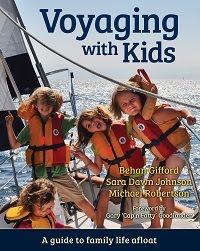 |
| Our nephew Oliver, along with Windy's brother, joined us aboard for the week in Glacier Bay. (Uncle Paul Valente) |
“I guess I was
underwhelmed.” I said to Windy.
“You’re kidding?”
“No, I guess I expected
more.”
She was speechless. Then
she countered: “Glacier Bay was the high point of the past two years cruising.”
We tried to understand
each other. I recounted for her some of the things we’d seen and done to-date, each
one of which seemed to me more dramatic or poignant than anything that just happened in
Glacier Bay.
“Those were all singular
experiences,” she said, “Glacier Bay was a week-long feast; I never knew where
to turn there was so much going on.” She went on to list all that came to mind.
That’s true, I thought,
we did sit on the bow of Del Viento, fifty yards from two young brown bears—no
other boat or human for miles—to watch them forage on the beach for nearly an
hour. No, I’d never seen anything like it in person either.
And indeed, there was a
loud crack and boom when the glaciers calved and the ice did seem to fall in
slow motion. Yes, we saw acres of broken ice, black with harbor seals
soaking in the sunlight. Yes, there were bald eagles and whales and sea otters.
We did wade through cold, fast-moving streams of glacial melt.
But I wasn’t feeling it
like she was. “I don’t even want to write a blog post about it.”
That was nearly a month
ago. We’ve since moved far away from Glacier Bay, on to other remarkable places
(like fifteen nights on Baranof and Chichagof Islands).
And I’ve thought back on
our time in the Park over and over. Each time it all seems more vivid. Today when
I look at our Glacier Bay pictures, they evoke emotions that are more powerful
and provocative then I remember feeling at the time.
Only now am I amazed
that the sharp, hard rock scree we walked across in front of a retreating
glacier was crushed and ground by a 300-foot tall wall of ice, still there when
my grandmother was a kid. I can see the entire landscape more clearly, now surreal,
a myriad of contrasting colors, textures, and shapes cast in Grand Canyon-like
proportions. Each evening rouge and purple sunsets lingered for an hour, expanding
across half the sky.
 |
| I can't believe how big my girls look next to their cousin; they're growing big faster than I realized. Here the gang is in Hoonah, AK. (Uncle Paul Valente) |
We started this new life
more than two years ago in Mexico, a place I’d spent a lot of time since the
1980s. Mexico felt like returning home. And the experiences we had there our
first year, the ones that really struck me, were isolated and easy to process
and assimilate. Our 6-month bash north from Baja to Vancouver Island was the same,
familiar ground with an even measure of stimulation.
But every northward mile
since leaving Victoria three months ago has been increasingly…and here is where
I don’t know what to say.
“Mind-blowing” and “profound”
and other superlatives come to mind, but they don’t capture my experience. It’s
almost like “disorienting” is a better word, but that’s not right either. It’s
just been one stimuli after another, almost every day. Like I’m Lucy in front
of that conveyor belt, and the chocolate candies just keep on coming, without
time to digest, reflect, and adjust before there is more. I take it in, but
it seems muted, like I’m failing to live in the moment.
I know we’re moving
faster than either of us would like, our itinerary is season-bound. But Windy
doesn’t react the same way to all of this. She is very much in the moment,
almost desperate to soak in all she can while it’s in front of her.
 |
| Don't mess with us. (Uncle Paul Valente) |
--MR
 |
| The near-extinction of these otters was one factor that led the Russians to put Alaska up for sale. (Uncle Paul Valente) |
 |
| Probably not too many girls have lost a tooth in Glacier Bay. (Uncle Paul Valente) |
 |
| Oli and the Robertsons hiking towards a glacier. Raging rivers of glacier melt kept us about a half-mile away, even after we waded through a couple. (Uncle Paul Valente) |
 |
| All of us back in Juneau on our last night together. (courtesy Uncle Paul Valente) |




























































